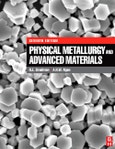Physical Metallurgy and Advanced Materials is the latest edition of the classic book previously published as Modern Physical Metallurgy and Materials Engineering. Fully revised and expanded, this new edition is developed from its predecessor by including detailed coverage of the latest topics in metallurgy and material science. It emphasizes the science, production and applications of engineering materials and is suitable for all post-introductory materials science courses.
This book provides coverage of new materials characterization techniques, including scanning tunneling microscopy (STM), atomic force microscopy (AFM), and nanoindentation. It also boasts an updated coverage of sports materials, biomaterials and nanomaterials. Other topics range from atoms and atomic arrangements to phase equilibria and structure; crystal defects; characterization and analysis of materials; and physical and mechanical properties of materials. The chapters also examine the properties of materials such as advanced alloys, ceramics, glass, polymers, plastics, and composites. The text is easy to navigate with contents split into logical groupings: fundamentals, metals and alloys, nonmetals, processing and applications. It includes detailed worked examples with real-world applications, along with a rich pedagogy comprised of extensive homework exercises, lecture slides and full online solutions manual (coming). Each chapter ends with a set of questions to enable readers to apply the scientific concepts presented, as well as to emphasize important material properties.
Physical Metallurgy and Advanced Materials is intended for senior undergraduates and graduate students taking courses in metallurgy, materials science, physical metallurgy, mechanical engineering, biomedical engineering, physics, manufacturing engineering and related courses.
Table of Contents
Atoms and atomic arrangements, Phase equilibria and structure, Crystal defects, Characterization and analysis, Physical properties, Mechanical properties I, Mechanical Properties II, Strengthening and toughening, Advanced alloys, Oxidation, corrosion and surface treatment, Non-metallics I Ceramics, glass, glass-ceramics, Non-metallics II Polymers, plastics, composites, Case examination of biomaterials, sports materials and nanomaterials, Numerical answers to problems, Appendix 1: SI units, Appendix 2: Conversion factors, constants and physical data, IndexAuthors
R. E. Smallman Emeritus Professor of Metallurgy and Materials Science, Department of Metallurgy and Materials, University of Birmingham, UK.After gaining his PhD in 1953, Professor Smallman spent five years at the Atomic Energy Research
Establishment at Harwell before returning to the University of Birmingham, where he became Professor
of Physical Metallurgy in 1964 and Feeney Professor and Head of the Department of Physical
Metallurgy and Science of Materials in 1969. He subsequently became Head of the amalgamated
Department of Metallurgy and Materials (1981), Dean of the Faculty of Science and Engineering, and
the first Dean of the newly created Engineering Faculty in 1985. For five years he wasVice-Principal
of the University (1987-92).
He has held visiting professorship appointments at the University of Stanford, Berkeley, Pennsylvania
(USA), New SouthWales (Australia), Hong Kong and Cape Town, and has received Honorary
Doctorates from the University of Novi Sad (Yugoslavia), University ofWales and Cranfield University.
His research work has been recognized by the award of the Sir George Beilby Gold Medal of the
Royal Institute of Chemistry and Institute of Metals (1969), the Rosenhain Medal of the Institute of
Metals for contributions to Physical Metallurgy (1972), the Platinum Medal, the premier medal of
the Institute of Materials (1989), and the Acta Materialia Gold Medal (2004).
Hewas elected a Fellowof the Royal Society (1986), a Fellowof the RoyalAcademy of Engineering
(1990), a Foreign Associate of the United States National Academy of Engineering (2005), and
appointed a Commander of the British Empire (CBE) in 1992. A former Council Member of the
Science and Engineering Research Council, he has been Vice-President of the Institute of Materials
and President of the Federated European Materials Societies. Since retirement he has been academic
consultant for a number of institutions both in the UK and overseas.
A.H.W. Ngan Professor, Department of Mechanical Engineering, University of Hong Kong.
Professor Ngan obtained his PhD on electron microscopy of intermetallics in 1992 at the University
of Birmingham, under the supervision of Professor Ray Smallman and Professor Ian Jones. He then
carried out postdoctoral research at Oxford University on materials simulations under the supervision
of Professor David Pettifor. In 1993, he returned to the University of Hong Kong as a Lecturer in
Materials Science and Solid Mechanics, at the Department of Mechanical Engineering. In 2003,
he became Senior Lecturer and in 2006 Professor. His research interests include dislocation theory,
electron microscopy of materials and, more recently, nanomechanics. He has published over 120
refereed papers, mostly in international journals. He received a number of awards, including the
Williamson Prize (for being the top Engineering student in his undergraduate studies at the University
of Hong Kong), Thomas Turner Research Prize (for the quality of his PhD thesis at the University of
Birmingham), Outstanding Young Researcher Award at the University of Hong Kong, and in 2007
was awarded the Rosenhain Medal of the Institute of Materials, Minerals and Mining. He also held
visiting professorship appointments at Nanjing University and the Central Iron and Steel Research
Institute in Beijing, and in 2003, he was also awarded the Universitas 21 Fellowship to visit the
University of Auckland. He is active in conference organization and journal editorial work.








